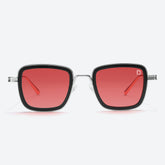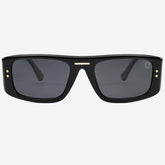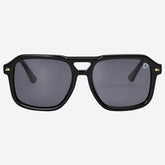Trivex vs Polycarbonate: A Complete Guide
Optic world has two popular names Polycarbonate and Trivex. The debate between trivex vs polycarbonate is going on for years. Both lenses are impact-resistant, lightweight, and scratch-free. The clarity of trivex is supreme. And the durability of polycarbonate knows no bounds.. In the eyewear industry: Trivex vs polycarbonate is an ongoing. Both have their own set of characteristics and limitations.
Why are you discussing trivex vs polycarbonate has an obvious reason. Glasses aren't just for fashion but protection. Harmful rays of sun damage the eyes. Dollger eyeglasses is helping you in this daunting task of finding the perfect lens. Dig deep and find out the advantages and disadvantages, comparisons, and answers to your questions. Welcome to the high-perspective world of trivex vs polycarbonate.
What are Polycarbonate lenses?

Polycarbonate lenses are unbeatable for decades. They enjoy a sizable market share with their impact resistance. Polycarbonate does not easily bend or break. Hence they're very common among children's or sports eyewear. They're made of strong yet lightweight plastic CR-39. Why is it trivex vs polycarbonate? What makes polycarbonate so special? What is it in polycarbonate lenses that other lens don't have?
Advantages:
Impact-resistance:
Impact-resistant polycarbonate glasses are very popular. They are the standard safety glasses. They do not easily break, bend, or fracture. Which makes them an excellent choice for kids, sports, or individuals with active lifestyles.
Lightweight:
Polycarbonate lenses are half the weight of regular glasses. They easily rest on your face without adding much bulk. This lightweight lens consists of soft material that absorbs energy without breaking.
UV-protection
Built-in UV protection is the most important reason contributing to polycarbonate glasses' popularity. There's 100 blockage of harmful sun rays. They filter UVA and UVB rays with their premium quality.
Durable Thin Frames:
Polycarbonate glasses with their streamlined appearance provide thin frames. These frames are durable and thin. Their lightweight design provides great comfort during extended wear. Accommodate strong prescriptions and treat high vision correctness with polycarbonate lenses.
Versatility:
These versatile polycarbonate glasses are so common. So you can incorporate whatever lens feature you prefer. Whether you want progressives, single vision, or polarised lenses. Polycarbonate gives you the plus point with a variety of treatments and coatings as well.
Disadvantages:
Aberration:
Aberration is the deviation from normal. Polycarbonate lenses offer minimal clarity. They have some distortions. Distortion is when someone sees vertical lines as curved. People with severe astigmatism will experience distortion. If your prescription is +/-4.0 diopters, then opt for trivex lenses to reduce aberration (chromatic distortion)
Scratch-resistance:
Scratch resistance is a crucial factor. This denotes the longevity of your polycarbonate lenses. When buying from somewhere else, you need to apply additional scratch-resistant coatings. If you want automatically applied coatings for your polycarbonate lenses, visit here.
Trivex lenses: What are they?

Trivex vs polycarbonate: which one to buy? Trivex lenses introduced and their sales skyrocketed. They are lightweight, impact-resistant, and provide maximum clarity. The greater visual clarity and zero distortion give them the upper hand. But they're expensive. The urethane-based pre-polymer of trivex lenses gives them optimal visual clarity, high-performance strength, and ultra-comfort. Delve deep into the advantages and disadvantages of trivex lenses.
Advantages:
Clarity:
Trivex lenses are made by a liquified monomer. Liquid is poured into molds and lenses are formed. This offers maximum clarity and minimal aberration. There's no chromatic distortion in these frames.
Scratch-resistance:
The unique molecular structure of trivex lenses ensures scratch resistance. Built-in scratch-free lenses require no special treatment. The hard and smooth surface makes them more durable and long-lasting.
Lightweight:
The lightweight trivex frame offers comparable thinness to polycarbonate glasses. The tensile strength of these glasses makes them perfect for rimless frames. Drilling holes won't make scratches in trivex lenses like polycarbonate lenses.
Impact-resistance:
Trivex lenses revolutionized the optical industry. These glasses are unbreakable. Promised safety and minimal risk of injury ensure the longevity of these expensive trivex glasses.
UV-protection:
The UV protection factor is a remarkable feature of both trivex and polycarbonate. The trivex vs polycarbonate debate ends with a maximum of 100% UV and blue protection of trivex lenses. Trivex lenses prevent cataracts, macular degeneration, and eye damage more effectively.
Disadvantages:
Cost:
Trivex lenses are expensive. There is a noticeable difference between the prices of trivex and polycarbonate. Trivex vs polycarbonate debate ends with your preference. The advantages and disadvantages are mentioned above. Opt for whatever goes with your lifestyle.
Limited Availability:
Another disadvantage of trivex is its limited availability. Though they offer zero distortion and maximum clarity. You can not choose various coatings, lens types, and frame styles. This could somehow reduce the strength of trivex lenses.
Trivex vs Polycarbonate: A comparison

The composition and design of polycarbonate and trivex lenses offer several benefits. UV protection, scratch resistance, and lightweight are the same. Trivex are just 10% thicker than polycarbonate glasses. Both materials have impact-resistance but trivex offers more to the wearer.
Another point to note is, that coatings applied enhance the margin of the strength. When struck by a pellet, polycarbonate lenses withstand the impact better. This means the additional coatings also influence the overall impact resistance. The availability of trivex is balanced.
The maximum clarity and wider more natural vision justifies the high prices. Polycarbonate is relatively inexpensive. Abbe value defines the optical clarity of lenses. The higher the number, the clearer the vision. Polycarbonate (as mentioned in the box) has a lower abbe value. This is the only drawback of polycarbonate lenses yet the most important one.
What frames are suitable for polycarbonate and trivex lenses?
1 Metal Frames:
The metal frames are lightweight. Polycarbonate lenses with their thinness ensure a sleeker and subtle appearance. The classic look of metal frames looks great with slightly thick trivex lenses as well.
2 Plastic Frames:
The styling options with polycarbonate plastic frames are endless. Bold and colorful plastic frames enhance the polycarbonate lenses. Along with versatility, the comfort and style are notable with trivex lenses. Dollger eyeglasses offers a stylish and comfortable eyewear experience with a variety of lens options in a variety of frames.
3 Rimless Frames:
The phrase shouldn't be trivex vs polycarbonate but trivex and polycarbonate. Both lenses complement well with rimless frames. They offer a sleek and modern look with aesthetic appeal. The barely-there feel of thin and lightweight polycarbonate lenses with rimless glasses creates a seamless fit. Buy one for your everyday wear today.
4 Semi-rimless Frames:
The combination of trivex with a lightweight frame enhances comfort, functionality, and style all at once. The stylish and practical combination of polycarbonate with semi-rimless glasses creates a timeless and versatile option. Buy today at Dollger eyeglasses and rock every outfit.
5 Sports Frames:
Sport frames are invincible. They do not break and withstand vigorous activities. The durable design and construction of polycarbonate and sports glasses offer maximum eye protection. With trivex, they offer stability and unparalleled protection. Lightweight renders reliability for unrestricted movements and comfort during outdoor activities.
FAQs
Q Are trivex lenses better than polycarbonate?
Trivex lenses offer optimal clarity, scratch-resistance, lightweight, and wider area of natural vision. But the polycarbonate lenses along with coatings and treatment could stack against trivex. Polycarbonate lenses are not easily breakable. They have thin frames and are budget-friendly. Look after individual preferences and prescriptions and make informed decisions.
Q Which lens quality is best?
Trivex lenses offer more clarity and the best lens quality. The abbe value of trivex lenses is more. The higher the value, the clearer the vision. They are ideal for higher prescriptions above +/-4.0 diopters. Astigmatism severe eye damage and vision correctness are done through trivex lenses.
Q What is the best material for eyeglasses lenses?
The best material for glasses is polycarbonate. These are made of CR-39 lenses – an upgrade of basic plastic. They offer minimal weight and are incredibly lightweight. They do not break, bend, or fracture. Making them an ideal choice for children or sports wear.
Q Who should wear trivex lenses?
People with an active lifestyle who require crisp and clear vision. Trivex lenses are optimal for people who prefer comfort and durability yet elegance and style. The most durable frame in the market is trivex. If you're looking for glasses with trivex visit Dollger eyeglasses. Dollger has real classic frames available at sale prices!
Conclusion:
Trivex vs polycarbonate is no longer a debate. The performance of both these lenses is remarkable. It also depends upon various factors including the initial procedures as well as treatments/coatings applied. Since Dollger eyeglasses is a huge fan of optical clarity. We would recommend trivex. But don't let the high prices shatter you. Go for additional coatings, and treatments, and let your budget-friendly polycarbonate lenses stack up against trivex lenses. Let your prescription, features, and frame preference choose the lens for you!





